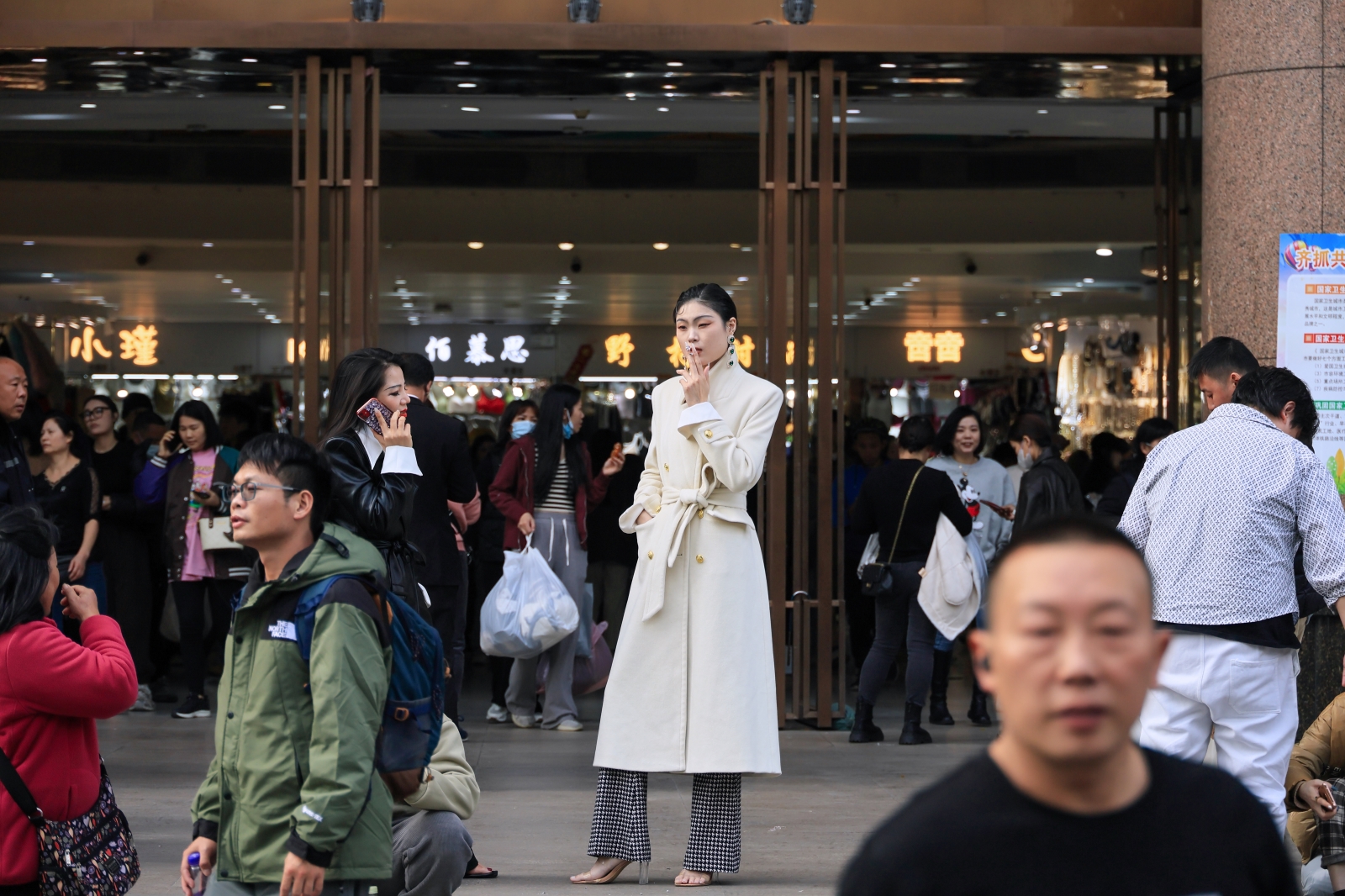How Shein exports China’s “sinking market”

Source:Chien-Tong Wang
Chinese e-commerce companies Shein and Temu have conquered the world, capturing teenage American girls. CommonWealth’s investigative team went deep into the territory behind Guangzhou-based Shein’s empire to understand how China is drawing the entire world into Shein’s vortex of consumption.
Views
How Shein exports China’s “sinking market”
By Ching Fang Wu, Ashley Lo, David ShenFrom CommonWealth Magazine (vol. 792 )
It is Christmas day, and what is a normal American family up to? Quite possibly, the daughter is wearing a dress purchased from Shein for US$10, the Christmas tree is adorned with cheap disposable ornaments from Temu, she scrolls through TikTok on her smartphone, ordering more cool, cheap items from the TikTok store.
China's trans-national e-commerce, by integrating with social media platforms, has long conquered the American market with Chinese goods.
According to market research firm Earnest Analytics, Shein dominated last year's Christmas season with a staggering 29% year-on-year growth in sales, surpassing retail giants like Target and Macy's by a wide margin.
Unstoppable “Made in China”
According to CNBC, Shein's annual revenue exceeded 30 billion US dollars, closely trailing Zara parent group Inditex with 38 billion US dollars. Achieving this remarkable success in just six years, Shein stands at the vanguard of China's e-commerce conquest of the United States.
Beginning with Shein, Chinese e-commerce sounded the clarion call for transoceanic ventures. Temu, a subsidiary of e-commerce giant Pinduoduo, entered the US market in 2022, experiencing nearly a tenfold increase in monthly website traffic within a year.
Over five years into the US-China trade war, major American brands have actively worked to diversify from “Made in China”, reshuffling supply chains. Meanwhile, small packages from the Shein, Temu, and TikTok online retail stores have ironically invaded American households like a guerilla force.
 Shein's Tokyo shop. (Photo: Ming-Tang Huang)
Shein's Tokyo shop. (Photo: Ming-Tang Huang)
In recent years, two terms have gained popularity in the realm of Chinese cyberspace: neijuan (内卷, “involution”) and xiachen shichang (下沉市場, “sinking market”). The former refers to excessive competition, while the latter originally indicated China's rural consumers, characterized by a large population with limited purchasing power.
These new e-commerce players employ a strategy of internal manufacturing competition, flooding European and American towns and villages with inexpensive goods, and have taken over the entire United States, starting with the youth. Next in their sights, aggressive Chinese e-commerce players aim not only for American wardrobes but also for the capital market.
Their target is the capital market. At the end of last year, Shein filed for an initial public offering (IPO) with the New York Stock Exchange, boasting an estimated valuation of 45 billion US dollars.
CommonWealth’s investigative team traveled to Panyu, Guangzhou, where we encountered Mr. Liu (a pseudonym), who previously served as a consultant for Shein in 2015.
Mr. Liu stated that Shein's initial goal was to achieve pricing at half the level of Zara. However, Shein's founder, Sky Xu (許仰天), insisted that they set their target at one-third of Zara’s retail prices. "He was thinking, in order to enter the US, he had to strike in such a way that Zara couldn't compete," offered Mr. Liu.
Xu hails from Guangzhou, a city with a rich history in the garment industry.
The Shisanhang (十三行), Baima (白馬), and Shahe (沙河) districts of Guangzhou are collectively known as the three largest wholesale apparel markets, not only in China but also worldwide.
 Buyers of e-commerce platforms, such as Taobao and Shopee put in their orders at the shops in the New China Building in the Shisanhang district, and the goods will be on their way to the globe afterward. (Photo: Chien-Tong Wang)
Buyers of e-commerce platforms, such as Taobao and Shopee put in their orders at the shops in the New China Building in the Shisanhang district, and the goods will be on their way to the globe afterward. (Photo: Chien-Tong Wang)
Shisanhang alone houses around 30,000 small shops, dispatching over 3,000 tons of goods daily. Tens of thousands of buyers visit these three major markets in person each day, many of whom showcase their purchases via livestreams to customers on the other side of the world.
While most of these goods find their way to the local Chinese market through platforms like Taobao, those that venture abroad and become popular women's fashion items in Taiwanese night markets, clothing stores, and e-commerce platforms like Shopee are often sourced from here. Further, it is a somewhat open secret that some e-commerce platforms claiming to specialize in Korean goods also frequently come to Guangzhou to procure goods for live sales in South Korea.
Adept at analyzing online fashion trends, Shein dispatches buyers to Shisanhang to purchase goods for the US market. Orders for the hottest-selling items are ordered right from the stalls, which are then fulfilled by the Guangzhou region’s 100,000 small workshops, with one such cluster in the Panyu district.
Manufacturers, workshops, and patterning studios proudly display signs that read Small Quantity, Rapid Turnaround (小單快返), emphasizing their ability to produce and ship small-batch orders within a week. This is a point of pride for this “soft supply chain.”
Shein has a minimum order quantity of 100, placing items directly on the platform. Popular items are quickly reordered from the small workshops. Thirty new styles are added at a time, and modifications and substitutions are made and testing continually conducted until a breakout hit is achieved. According to Shein's data, the success rate in this guessing game is as high as 50 percent.
The key lies in the unique “urban villages” of Guangzhou, surrounding the clothing wholesale markets and fabric markets. The land belongs to the village collectively rather than the government, making relocation difficult. Sprouting densely in the crevices between tall buildings, the manufacturing villages offer affordable rent.
In the opaque landscape of China, CommonWealth’s investigating team witnessed the world's most transparent supply chain system.
Shein's digitized management approach has been incorporated among all suppliers, providing a clear view of progress at each stage. From design to manufacturing and shipping, the system indicates the progress of different suppliers at each stage. Feedback on the performance of each item is instantly accessible to small workshops through the system.
This is a level of transparency in business operations that conventional textile industry brands would find impossible to share with their suppliers, as it involves proprietary business secrets.
Shein also eliminates the bargaining process by setting fixed profit margins for products across different price ranges, thus saving negotiation costs. The production allocation for each popular item is determined by who gets there first. Suppliers are managed through a performance-based grading system that stimulates internal competition.
With non-negotiable profits and a competitive order process, why do suppliers remain committed? The answer lies in the swift payment cycle, with delivery to payment settlement averaging 15 days. High-rated suppliers can receive their payments as quickly as seven days, a significant improvement over the traditional payment periods that can extend up to three months.
Specializing in the transnational company sector, James Liang, founder of Skyline Ventures, notes, “China has the world's leading e-commerce standards, and when they go abroad, they simply dominate.” In the midst of a sluggish Chinese economy and severe internal competition, Shein and Temu have effectively drawn the entire world into the vortex of a “sinking market”.
 Shein has expanded its investment in logistics efficiency, with a total investment of more than NT$10 billion. (Photo: Chien-Tong Wang)
Shein has expanded its investment in logistics efficiency, with a total investment of more than NT$10 billion. (Photo: Chien-Tong Wang)
Affordable Fashion Pacmans American Small-town Market
America certainly needs inexpensive goods.
In 2018, the trade war between the United States and China began, with the U.S. announcing several rounds of tariff lists, including those affecting the apparel industry. Interestingly, despite a 20% decrease in import value, the import quantity of Chinese clothing to the U.S. only saw a modest decline of 6% from 2018 to 2022. The decrease in average import unit price is attributed to the rise of cross-border e-commerce.
As the U.S. reduced its buying activities and wholesale markets in China hesitated to place orders during the COVID-19 pandemic, cross-border e-commerce platforms like Shein played a crucial role in alleviating the challenges faced by many small workshops.
"All our current orders come from them," said Mr. Ding, the owner of a small workshop. While Shein may offer lower profits to suppliers and sometimes even half of the offline wholesale prices, the consistent and substantial volume of orders makes it hard to decline.
This shift is primarily for the benefit of American teenage girls. When Shein entered the U.S. market in 2012, its initial focus was on establishing a presence on platforms like Facebook, Instagram, and Pinterest.
Professor Chen Guoli of the European Institute of Business Administration analyzes that in the past, American high school girls had limited choices due to weekend shopping with parents and constrained budgets. With the widespread use of social media in recent years, the expression of individual desires has become stronger. This represents an untapped market that has yet to fully emerge, a "blue ocean" of unmet needs.
 From the fast fashion of Zara to the ultra-fast of Shein, consumers have more and more options for products, raising some environmental and human rights issues. (Source: Getty Images)
From the fast fashion of Zara to the ultra-fast of Shein, consumers have more and more options for products, raising some environmental and human rights issues. (Source: Getty Images)
However, an American IPO could prove to be a dead end.
Having gone through nine rounds of funding, bolstered by ample capital, Shein has adopted the e-commerce model of burning money through subsidies. However, cost reduction has proven challenging.
"Shein is nothing special”
Shein has encountered obstacles from the Chinese government. According to a report by the Wall Street Journal, China's Office of the Central Cyberspace Affairs Commission is investigating Shein’s handling of data related to Chinese employees, suppliers, and partners, and whether data leaks outside the country can be prevented. This adds more variables to Shein's path towards an American IPO.
At the same time, Shein's production model of following fashion trends closely, has faced criticism for plagiarism. Last year, Uniqlo sued Shein for copying a bestselling bag and selling it at a lower price. The Wall Street Journal reported in 2022 that Shein was facing at least 50 intellectual copyright infringement lawsuits.
Furthermore, Shein is under scrutiny for its poor working environment. Visits to small workshops revealed to us that cramped and dirty conditions were commonplace.
When asked about the uncertain future before the IPO, if Shein were to demand more stringent conditions, worse prices, or even a reduction in order volume, would there be concerns about losing a major client? Lin Feng responded, "If it's gone, it's gone. Shein is nothing special." He explained that small workshops work with many clients at the same time, and that no one relies solely on one customer. Moreover, with the abundance of emerging cross-border e-commerce platforms in China, “there will always be other choices.”
As long as China continues to face production overcapacity, Chinese manufacturing will remain unstoppable.
Have you read?
- Taiwan-made machinery is still sold in Russia, what can the manufacturers do about it?
- ‘Made by China’ Hiding in SE Asia: A 10-year analysis of Apple supply chain
- U.S. weapons maker Northrop Grumman to add Taiwan to its supply chain
Translated by David Toman
Uploaded by Ian Huang






